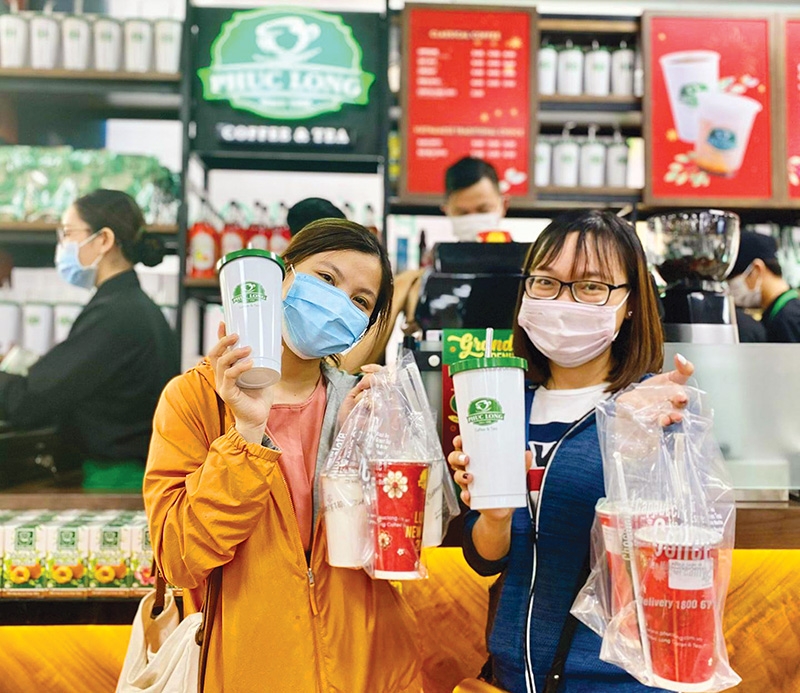Coffee and beverage chains fire up competition with kiosks
 |
| Kiosks can help beverage chains to rapidly expand at minimal cost. Photo: Le Toan |
Phuc Long’s coffee and beverage chain is cooperating with Masan Group to develop a Phuc Long kiosk model at more than 2,200 stores Vinmart+ stores, which is expected to shake up the coffee and beverage chain market across the country.
The information comes after The Sherpa, a member of Masan Group, decided to spend $15 million acquiring a 20 per cent stake in Phuc Long Heritage, which owns the Phuc Long coffee and tea brand.
According to a representative of Masan Group, the cooperation is part of the strategy to build a point-of-life consumer-retail platform, and the two sides will jointly seek solutions to increase synergies. Phuc Long kiosks will share 20 per cent of revenue with VinMart+, which is in the process of being renamed Winmart+ after Masan’s takeover. The two sides also set a target to open 1,000 more Phuc Long kiosks in the next 18-24 months based on the test results of four Phuc Long kiosks in Ho Chi Minh City over the past few months.
The success of the model could help increase the number of points of sale of Phuc Long from 82 current stores to more than 2,000 in the future.
Despite being rated as a notable name in the Vietnamese coffee and beverage market, with the number of retail stores only dragging behind Highlands Coffee (about 365 stores), The Coffee House (176 stores), and Trung Nguyen (over 300 stores), and even surpassing Starbucks, the rapid expansion strategy also made it impossible for Phuc Long to achieve high profits.
In 2019, Phuc Long only made a profit of $870,000 while revenues were up to $33 million. Deploying new models from 2021 such as opening kiosks inside supermarkets and then coworking spaces is considered one solution to help the brand save management costs and increase scale.
Phuc Long’s direction is not new. Many coffee and beverage brands have also previously cooperated with other brands to develop a coffee kiosk model with the aim of sharing less space rental costs, especially when the food and beverage (F&B) industry is facing many difficulties due to COVID-19.
Pioneering this model was cooperation between Ong Bau Coffee and the Ba Gac restaurant chain. A representative of Ong Bau said that using the same premises, in addition to saving the cost of opening a store, also helps it approach Ba Gac’s customers, which are often young people and office workers in surrounding areas. The combination will promote Ong Bau Coffee to continue accompanying many other brands to achieve the goal of 10,000 points of sale by the end of 2022.
Similarly, the opening of kiosks at Co.opSmile supermarkets and many other buildings is also helping Guta coffee brand revenues increase by 200-300 per cent per year.
Guta CEO Nguyen Minh The said, “Guta expects to maintain this growth and expand its brand identity in the next few years.” Guta has nearly 60 points of sale, mainly in Ho Chi Minh City, and is planning to expand to Mekong Delta provinces.
There have also been other partnerships such as Laha Cafe with Bach Hoa Xanh, and King Coffee with Co.opSmile.
The newly launched milk tea, coffee, and beverage brand from Kido Group, Chuk Chuk, also announced that it would promote the development of the kiosk model in Ho Chi Minh City. Chuk Chuk’s goal is to increase the number of stores to 58 by the end of this year and become the leading brand in the F&B market in terms of coverage with about 1,000 retail stores nationwide by 2025.
Many domestic coffee chains are using the kiosk model to increase their presence and expand the number of stores despite the pandemic. It is a solution to help coffee and beverage brands gain market share, especially as coffee chains are the only F&B segment with a growth rate of 10 per cent that has no dominant player.
According to Euromonitor’s research in 2020, Vietnam’s coffee and tea market is worth about $1 billion, but today’s popular brands Starbucks, Highlands Coffee, The Coffee House, Phuc Long, and Trung Nguyen account for about 25 per cent of the market.
What the stars mean:
★ Poor ★ ★ Promising ★★★ Good ★★★★ Very good ★★★★★ Exceptional
 Tag:
Tag:
Related Contents
Latest News
More News
- Businesses ramp up production as year-end orders surge (December 30, 2025 | 10:05)
- Vietjet chairwoman awarded Labour Hero title (December 29, 2025 | 13:06)
- How to unlock ESG value through green innovation (December 29, 2025 | 10:03)
- AI reshapes media and advertising industry (December 29, 2025 | 08:33)
- FPT and GELEX sign deal to develop blockchain tech for global markets (December 29, 2025 | 08:29)
- Vietnam’s GDP forecast to grow by 9 per cent in 2026 (December 29, 2025 | 08:29)
- Women entrepreneurs are key to Vietnam’s economic growth (December 29, 2025 | 08:00)
- Vietnam's top 500 value-creating enterprises announced (December 27, 2025 | 08:00)
- The PAN Group shaping a better future with ESG strategy (December 26, 2025 | 09:00)
- Masan Consumer officially lists on HSX, marking the next phase of value creation (December 25, 2025 | 13:20)























 Mobile Version
Mobile Version